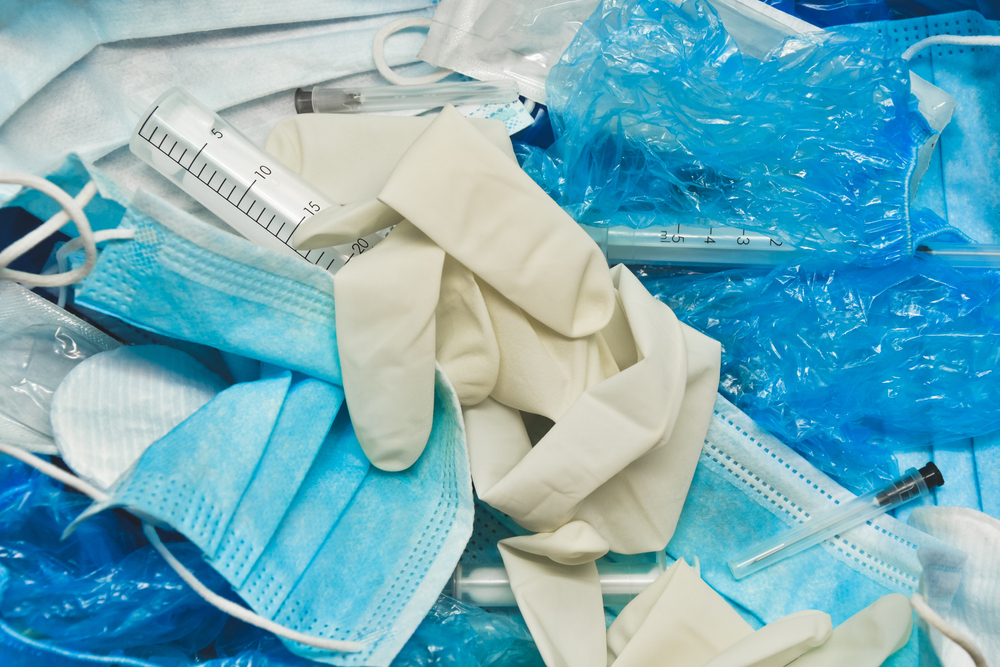The health care sector is a substantial contributor to the plastic pollution crisis due to our reliance on single-use plastic packaging.
We manufacture more and more plastic every year. Plastic production has doubled in the last two decades, with over half of all plastic manufactured in the last 13 years. Around half of the plastic we produce today is single-use plastic, and is often used for mere minutes before being discarded, yet it persists in our environment for hundreds, even thousands of years, polluting our oceans, soil, drinking water, air and bodies. And we know plastic waste is not inert — as was initially claimed — but is harming our planetary and human health.
The health care sector is a substantial contributor to this plastic pollution crisis. Around one-third of our waste is plastic and predominantly single use. Plastic packaging of medical devices, therapeutics and equipment in particular plays an outsized role as it constitutes 40% of health care’s plastic waste. Therefore, through the delivery of our care, we are harming our planet and our patients. Especially, the health of future generations, who will suffer the consequences of the proliferating plastic pollution most acutely. As described in The Rockefeller Foundation – Lancet Commission, “we have mortgaged the health of future generations … to realise gains in the present”.

Plastic packaging waste costs health care
Plastic packaging of medical goods is generally soft plastic or made of composite plastic, which has poor recyclability. Soft plastic costs up to 50% more to recycle into plastic resin than resin derived from virgin fossil fuel feedstocks.
Overall, the environmental costs of Australia’s packaging waste has been calculated to be $340 million per year in the form of water pollution, emissions, soil contamination and water and energy usage.Analysis from Australian Packaging Covenant Organisation (APCO) in 2024 suggests that packaging sent to landfill in Australia has an estimated unrealised value of $900 million. This highlights a significant capacity for health care to reduce its environmental impact and make substantial cost savings through changes to its management of packaging and packaged items. Western Health in Melbourne implemented a reusable surgical gowns program, resulting in savings of over $100 000 per year. Greater opportunities remain to further reduce unnecessary and excessive plastic packaging. For example, sterile items in a single-strike wrap have no increased risk of contamination than those in the usual double wrap.
Plastic waste is not just about cost – it has significant health impacts
Health impacts can arise as plastic degrades and fragments into microplastics, and as chemical additives and plasticisers leach out during all stages of the plastic lifecycle. A recent study in the New England Journal of Medicine examined atherosclerotic plaques for microplastics in 257 patients undergoing carotid endarterectomy for asymptomatic carotid artery disease. It identified 150 patients (58.4%) with microplastics, consisting of polyvinyl chloride and polyethylene, embedded in these plaques. The patients with microplastics were observed to have significantly more cardiovascular and cerebrovascular events than the controls (hazard ratio, 4.53; confidence interval, 2.00–10.27, P < 0.001). Moreover, microplastics have been found in virtually every human organ including our brains, testicles, placentas, breast milk and even in fetal meconium. Thus, from conception, we are subjected to plastic exposure.
In vitro studies have demonstrated that micro and nanoplastics are transported into cells through lysosomes, where they then become cytotoxic and stimulate oxidative stress and inflammation. Ragusa and colleagues identified human placental cells containing nanoplastics, which exhibited mitochondria and endoplasmic reticulum dysfunction. Similar to the pathology findings observed in pre-eclampsia and intra-uterine growth restriction.
Plastics contain additives and plasticisers that give unique properties such as stain resistance or heat stabilisation; however, exposure to these additives has been linked to endocrine disruption. For example, PFAS (per- and polyfluoroalkyl substances, also known as forever chemicals due to their exceptionally long half-life) used in products such as Gortex and Teflon, have been strongly associated with low birth weights, obesity and thyroid dysfunction. Other endocrine disrupting chemicals such as phthalates and bisphenol A, have been linked with infertility, impaired fetal neurodevelopment and several cancers.
Plastic packaging has substantial environmental costs
Plastics contribute significantly to climate change. Some 98% of plastics are derived from virgin fossil fuels and are responsible for 3.7% of global greenhouse gas emissions. Plastic production is only expected to accelerate as consumption and demand increase and by 2040, plastic is expected to be responsible for around 20% of global emissions.
Additionally, plastic pollution has substantial impacts on biodiversity. A report by the Secretariat of the Convention on Biological Diversity found that more than 800 marine species are affected by plastic pollution and by 2050, it is predicted that there will be more plastic in the oceans by weight than fish. Packaging is a critical contributor to this plastic pollution. Clean Up Australia found that plastics accounted for 81% of litter in 2022–23, most of which was plastic packaging.
Proposed solution
Currently packaging is under a co-regulatory arrangement. Both industry and government share the responsibility of managing the impacts of packaging waste. However, an independent review in 2021 found significant failures in implementation, industry compliance and enforcement. The APCO, a non-governmental organisation responsible for industry-led stewardship schemes for packaging, confirmed that the current national packaging targets will not be met. The Australian Government endorsed the findings of the review and agreed to reform Australia’s packaging regulations. This reform engaged with stakeholders involved in the production, use and recovery of packaging. In December 2024, we expect to hear the Australian Government’s report on the consultation process, followed by an announcement in 2025 on the direction of the new packaging regulations, which will likely take effect from 2026 onwards.
Doctors for the Environment Australia (DEA) has just contributed a submission to the National Reform of Packaging Regulation consultation, with a focus on the impacts of packaging in health and health care.
To effectively reduce the production of and improve the recovery of packaging, DEA advocates for the implementation of a mandatory product stewardship scheme for packaging, as proposed by the Boomerang Alliance advocacy network. This scheme would hold industries financially and legally responsible for the packaging that they manufacture and place on the market.
Under such a model, eco-modulated fees would apply to all packaging – this entails adjustable fees proportional to the environmental impacts of the packaging. If it contains circular design choices, such as incorporating increased recycled materials or designed for reuse, then it would have a lower fee than packaging that did not meet these same targets. The fees collected could fund the scheme and be used to build material recovery facilities and improve waste collection systems.
Furthermore, DEA proposes a ban on chemicals of concern such as PFAs and problematic single-use packaging that cannot be recovered. The scheme should be enforced by an independent regulator to ensure businesses are held to account and are meeting the mandatory targets set. Industry self-regulation has already been proven to be ineffective and is clearly not up to the challenge of the plastic waste crisis.
Extended producer responsibility schemes have been successfully implemented elsewhere with the European Union introducing the Packaging and Packaging Waste Regulation. This promotes circularity and sustainability with eco-modulated fees to incentivise recyclability and other sustainable design choices while also setting mandatory targets for packaging reduction, recycling rates, reuse and the inclusion of recycled content. This substantially reduces packaging waste sent to landfill.
To address the growing health, environmental, and financial consequences of increased packaging production and pollution, Australia needs an extended producer responsibility scheme for packaging. This has the potential to deliver significant benefits, including strong incentives for behaviour change and innovation, flexibility for regulated entities to improve, and nationally consistent regulations while aligning our domestic markets with international best practice.
Dr Mitchell Hickson is an NSW physician and a member of Doctors for the Environment Australia, where he chairs the plastic and waste pollution special interest group
The statements or opinions expressed in this article reflect the views of the authors and do not necessarily represent the official policy of the AMA, the MJA or InSight+ unless so stated.
Subscribe to the free InSight+ weekly newsletter here. It is available to all readers, not just registered medical practitioners.
If you would like to submit an article for consideration, send a Word version to mjainsight-editor@ampco.com.au.

 more_vert
more_vert
Great in-depth article on our medica plastic problem. Ever since China stopped taking our waste in 2018, things got a lot worse. Companies like GreenLabs Recycling in the US is trying to bridge the gap but we need more of a concerted effort.
While GP land is most likely not a massive contributor, I would love to see a service , maybe via the RACGP, any GP surgery could contact to get practical viable, individual advice/review on how to minimise waste. It just does not make sense that each GP has to do their own research ( …) into options and it slows the whole transition unnecessarily down.
The author doesn’t mention that any plastic article contaminated with bodily fluids must be incinerated, with many such processes being incomplete and aerosolising fragments. Only the clean waste plastic can go to landfill, or be recycled. Although the bad old days of blunt reusable needles are well left, minuscule risks of vCJD (Mad Cow disease) etc. have led to much more disposable plastic use.
And the brutal economic reality, is that Australian labour is so expensive that it’s cheaper to buy surgical gowns, drapes, plastic bowls etc from China (including shipping costs) than it is to launder/sterilise them in the hospital. My public hospital (on a tight budget) closed its laundry long before the private hospital did. Every operation generates at least 2 or 3 large garbage bags of waste, 40 years ago there was one small bag of disposables (mostly cotton sponges, natural latex gloves and steel scalpel blades) and 2 large linen bags to launder.
AIDS led to double-gloving for most operations, and glove use for routine procedures like injections or suture removal. The massive increase in latex demand led to laxer standards of manufacture, increased latex monomer contamination, and a consequent surge in latex allergy – so now all hospitals stock latex-free (i.e. plastic) gloves. AIDS now has drugs which render patients’ blood non-infectious, but the fashion to double-glove for procedures remains prevalent. Covid added to the overkill by making disposable ‘PPE’ de rigeur.
A simple solution would be to ban disposable gowns, plastic scalpel trays, dishes and bowls, other than for incredibly rare situations like known CJD cases. Reverting to linen/steel would have minimally increased blood-borne risk (or airborne risk in a respiratory virus like Covid), but a great decrease in plastic disposables.
Needles are thrown into a ‘sharps’ bin for incineration (the entire plastic bin is incinerated along with the contents). To prevent self-inflicted needle-stick injuries, the infection control advice is not to re-sheathe a needle, discarding the entire plastic syringe into the bin for incineration. Learning to re-sheathe one-handed carries no risk of needle stick, and decreases the non-recyclable plastic waste by over 90%. A more ambitious scheme would be to use modern manufacturing capabilities to make Luer-lock glass syringes, either reusable or 100% recyclable. Although Lucas Heights lacks the capacity, a proliferation of civilian nuclear reactors would allow large-scale local Cobalt-60 Gamma-ray sterilisation (scalpel blades and many needles are already Gamma sterilised) with much lower environmental impact than shipping Chinese-made plastic syringes, particularly those sterilised with carcinogenic Ethylene Oxide.
Well done Dr. Hickson!
Reusable medical equipment can replace single use equipment (less waste, less carbon, less water use over the life cycle). It’s extraordinary that in 2024 most hospitals and other healthcare facilities use large amounts of single use gowns, drapes, simple plastic bowls, metalware etc. But this aint necessarily so, with considerable effort on the part of a team of clinicians we have made the change at Western Health (Melbourne), and other healthcare facilities around the country.
Further, reusable equipment requires less packaging, bringing an unexpected bonus. For example, reusable facemasks or drug trays used in the operating room require far less packaging (bundled together) than single use masks and trays (individually gift wrapped).
Onwards together!
Great to see awareness improving of the impact of plastics on human health and the healthcare system’s contribution to the plastic waste crisis. ‘Essential’ use of plastics needs to be evidence-based and minimising plastic use and its waste needs to be part of usual operations in health care, including accreditation standards. And practical guidance is needed for decision-makers at all levels to make it happen. ‘First do no harm’.
Excellent essay which highlights the consequences of our plastic consumption and identifies some practical processes that could be employed to lessen our plastic burden on health and the environment.
We look forward to the Australian Government’s report of the new packaging regulations due for release 2025 and hope it facilitates real action. It is of course important that all of us amend our behaviours to reduce plastic use.
For now, we need to ensure we thoroughly burn it all, completely gasify it, and use the heat generated by it to at least produce electricity, hot water and steam for the hospital and surrounding users.
We can restrict certain types of plastics and restrict certain colours in the short term, and in the long term develop plastic-free alternatives.
But unfortunately the ONLY VIABLE solution presently is to ensure it is burned and gasified completely.
Thank you for a thought provoking and sadly accurate reflection on the use of plastic wrapped single use items in health care and the harmful consequences of these products
Very sobering information contained in this article. We have become addicted to plastic and dismissive of its long term effects on human health and the planet.
Thank you for this call to action.
Why is the article not talking about the most effective way to reduce plastic waste in healthcare – which is not to generate it in the first place?
We all need to take on ourselves and our colleagues to stop doing unnecessary tests and also to stop using more plastic than needed – gowns for example are often completely unnecessary and larger long sleeved ones used when smaller no sleeved ones would suffice….
Our colleagues in ID and the legal fraternity need to remove themselves from clinical care a little to help reduce unnecessary generation of plastic waste
Excellent article. Lead, arsenic, and mercury as well as PFAS in tampons and other menstrual products, which come into prolonged contact with sensitive tissue, microplastics throughout the body…but all we hear about is carbon dioxide.
V important that as health professionals we take responsibility for our plastic waste. It’s costing us money, and harming human and planetary health so very much part of our duty of care to do something about this.
Thanks Dr Hickson for this great article, esp showing ways forward and how we as clinicians have an opportunity to act. Obviously we need top down action but we can also do the right thing in our own practices.